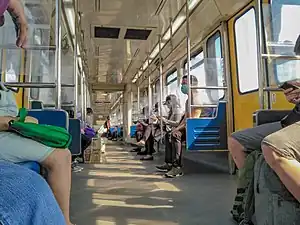| LRTA 1100 class | |
|---|---|
_1100_LRV_2021-12-18.jpg.webp) 1100 class train at Monumento station in December 2021 | |
 1100 class interior in June 2020. | |
| In service | 1999–present |
| Manufacturer | Hyundai Precision[lower-alpha 1] ADtranz[lower-alpha 2] |
| Built at | Changwon, South Korea |
| Constructed | 1997–1998 |
| Entered service | 1999 |
| Refurbished | 2019–2020 |
| Number built | 28 vehicles (7 sets) |
| Number in service | 20 vehicles (5 sets) |
| Formation | 4 cars per trainset (Mc–M–M–Mc)[lower-alpha 3] |
| Fleet numbers | 1101–1128 |
| Capacity | 1,358 passengers[lower-alpha 4] |
| Operators | Light Rail Transit Authority (1999–2015) Light Rail Manila Corporation (2015–present) |
| Depots | Baclaran |
| Lines served | LRT Line 1 |
| Specifications | |
| Car body construction | Stainless steel |
| Train length | 105.7 m (346 ft 9 in)[lower-alpha 5] |
| Car length | Driving head cars:26.35 m (86 ft 5 in) Intermediate cars:26.5 m (86 ft 11 in) |
| Width | 2.59 m (8 ft 6 in) |
| Height | From top of rail:3.74 m (12 ft 3 in) Pantograph locked down:3.95 m (13 ft 0 in) |
| Floor height | 920 mm (3 ft 0 in) |
| Platform height | 690 mm (2 ft 3 in) |
| Entry | Step |
| Doors | 4 per side, sliding pocket-type; 1,500 mm × 1,900 mm (4 ft 11 in × 6 ft 3 in) |
| Articulated sections | 2 per LRV |
| Wheel diameter | New: 660 mm (25.98 in) Worn: 600 mm (23.62 in) |
| Wheelbase | Per bogie:2.31 m (7 ft 7 in) Bogie centers:10 m (32 ft 10 in) Total:20 m (65 ft 7 in) |
| Maximum speed | 60 km/h (37 mph) |
| Weight | Head car:37.4 t (82,000 lb) Intermediate car:36.5 t (80,000 lb) |
| Axle load | 10.7 t (24,000 lb) |
| Steep gradient | 4% |
| Traction system | Adtranz[lower-alpha 6]/Voith[lower-alpha 7] IGBT–VVVF |
| Traction motors | 4 × 125 / 170 kW (168 / 228 hp)[lower-alpha 8] 3-phase AC induction motor |
| Power output | Original: 500 kW (670 hp) Refurbished: 680 kW (910 hp) |
| Acceleration | 1.1 m/s2 (3.61 ft/s2) |
| Deceleration | Service: 1.3 m/s2 (4.27 ft/s2) Emergency: 2.08 m/s2 (6.82 ft/s2) |
| Auxiliaries | Auxiliary inverter |
| HVAC | Air-conditioned; roof-mounted duct type (2 units per LRV) |
| Electric system(s) | 750 V DC overhead wire |
| Current collector(s) | Single-arm pantograph |
| UIC classification | Bo′+2′+Bo′ |
| Wheels driven | 8 out of 12 per LRV |
| Bogies | Outside-frame type |
| Minimum turning radius | 25 m (82 ft 0 in) |
| Braking system(s) | Regenerative and pneumatic |
| Safety system(s) | ATS (1999–2007) ATP (2007–present) |
| Coupling system | Semi-permanent |
| Multiple working | Within type |
| Track gauge | 1,435 mm (4 ft 8+1⁄2 in) standard gauge |
| Seating | Longitudinal |
| Notes/references | |
| [1][2][3][4][5][6][7][8][9][10][11] | |
The LRTA 1100 class is the second-generation class of high-floor light rail vehicles of the Light Rail Transit Authority (LRTA) in Manila, Philippines, which began operation in 1999.[4][12]
Purchase
The LRT Line 1 in Metro Manila reached its capacity in the 1990s. As such, expanding the capacity of Line 1 was needed. Initially, 32 cars with identical specifications to the 1000 class trains were planned to be ordered for the 32 two-car trains operating at the time so that each train would consist of three cars. However, with the increasing transport demand, four-car trains were instead ordered.[13]
On October 18, 1996, Hyundai Precision signed a contract to produce 28 cars (7 sets) for the LRT Line 1. These cars were produced between 1997 and 1998 as its first manufactured light rail vehicle.[4] The capacity extension project was due to traffic congestion and air pollution, which in turn led to an increased demand for public transport in Metro Manila by the LRT Line 1.[14][15][16][17][18][13]
The trains were provided by the AML consortium, a consortium consisting of Marubeni Corporation, Adtranz, and ABB.[19]
The capacity expansion project was funded by Japan's official development assistance.[19] The handover ceremony and test-run of the 1100 series LRV was done with former President Joseph Estrada and former Vice-President Gloria Macapagal Arroyo in 1999.
Design
The 1100 class are the first 6-axle (3-bogie) light rail vehicles with two articulated cars in the entire rolling stock of the LRT Line 1, as its predecessor, the 1000 class, was built to the 8-axle (4-bogie) design with three sections.
Car body
The train car body is made of stainless steel. Each LRV has four sliding pocket-type doors per side. The 1100 class trains are 90 millimeters (3.5 inches) wider than the 1000 class.[1]
Similar to the 1000 class, the 1100 class have cheatlines of blue and yellow that run through its sides. The trains also served as a prototype for future LRVs made by Hyundai Precision, which bears resemblance to the trains used in the Adana Metro and the Istanbul T4 Line.
Each light rail vehicle has two roof-mounted air-conditioning units. In total, there are eight air-conditioning units in a four-car train set.[1]
 1100 class train at Gil Puyat station in November 2006
1100 class train at Gil Puyat station in November 2006_Balintawak_station_2021-06-05.jpg.webp) A refurbished 1100 class train in June 2021. Note the new controller box under the door that has been supplied by Voith.
A refurbished 1100 class train in June 2021. Note the new controller box under the door that has been supplied by Voith.
Interior
The trains have longitudinal seating. A wheelchair provision is present near the articulated portion of the intermediate cars.
.jpg.webp) Image shows stanchions, ACU vents, and briefly, the builders' plate.
Image shows stanchions, ACU vents, and briefly, the builders' plate. 1100 class train with seats removed, showing wheelchair space.
1100 class train with seats removed, showing wheelchair space. View of driving cab before the 2019-2020 refurbishment.
View of driving cab before the 2019-2020 refurbishment.
Mechanical
The bogies are of outside-frame type. Each LRV has three bogies consisting of two motorized bogies at the ends of the LRV and one trailer bogie under the articulation.[20] The primary suspension is a chevron rubber spring, while the secondary suspension is an air suspension, similar to the 1200 class.[5]
Semi-permanent couplers are present in the ends of each light rail vehicle except the driving cab section of the MC car.
Traction
The 1100 class trains are the first Line 1 trains to have an IGBT–VVVF traction control system, with each VVVF inverter driving two 3-phase alternating current, enclosed-type induction motors. The original traction motors have a power output of 125 kilowatts (168 horsepower), while the new traction motors installed during the refurbishment period have a power output of 170 kilowatts (230 horsepower).[20]
The original VVVF controller is supplied by ADtranz, while the new VVVF controller installed during the refurbishment period is supplied by Voith.[20]
The traction equipment in a refurbished train has two Voith EmCon I1000-9AU traction inverters with 350 kVA continuous power in each, two auxiliary inverters, and a VPort IO control unit.[20]
The trainset produces a distinct high-pitched acceleration sound that is unique to the Adtranz VVVF controller used, a trait present in the train's derivative models. After the refurbishment, the traction acceleration sound is now identical to the one used in the MRTC 3100 class trains, as its traction controller is manufactured by Voith as well.
Formation
| Four-car configuration | ||||||||
| Car No. | 1 | 2 | 3 | 4 | ||||
|---|---|---|---|---|---|---|---|---|
| Designation[5] | MC | M | M | MC | ||||
| Numbering[21] | 1101A | 1101B | 1102A | 1102B | 1103A | 1103B | 1104B | 1104A |
| Seated[5] | 78 | 82 | 82 | 78 | ||||
| Standing[5] | 252 | 267 | 267 | 252 | ||||
| Total[5] | 330 | 349 | 349 | 330 | ||||
Details of the car designations are listed below:
- MC - driving head car
- M - intermediate car
Operations
The 1100 class entered service in 1999, which raised the line's capacity by half[22] from a carrying capacity of 18,000 passengers per hour per direction to 27,000 passengers per hour per direction.[23] After 2001, many vehicles left the service owing to problems in operations and maintenance.[24] Although spare parts had been substantially given in 2004, 14 cars remained out-of-service due to the lack thereof as of 2013, including two cars involved in a collision.[25][26][27] Most of the spare parts for the trains, including brake parts, were only procurable from ADtranz.[10] There were attempts to procure spare parts, but these attempts failed. This was affected by the acquisition of ADtranz by Bombardier Transportation in 2001 (later acquired by Alstom in 2021). Furthermore, parts in the 1200 class and the 1100 class only share 20% commonality.[28]
In addition, these trainsets are commonly used as "skip trains" or trains meant to target a particular station due to extremely high volume of passengers, especially during rush hours. However, these trainsets now stop at all stations when Metro Manila was placed under General Community Quarantine in June 2020 (and eventually, the alert level system in September 2021) as a response to the COVID-19 pandemic.
The 1100 class trains normally operate in a 4-car configuration. Under special operating conditions, the trains can operate at a 3-car[29] or 2-car configuration.
A 1100 class trainset was used for the first test run of the LRT Cavite Extension Phase 1 on December 19, 2023. According to the Light Rail Manila Corporation, the 1100 class is the widest in terms of car body, making it the most strategic option to check for initial compatibility of station platforms, walkways, cableways, and others.[30]
Refurbishments
Before the rehabilitation of the 1100 class trains, 2 out of the 7 sets remained in service. One of the train units was also involved in a collision as well, causing it to be put out of service due to damaged train body.[2] Rehabilitation was initiated by the Light Rail Manila Corporation in 2018, which aimed to restore the inactive fleet into serviceable conditions and increase the capacity of Line 1. In February 2018, LRMC and Voith signed an agreement to refurbish the said fleet which includes the control devices, traction systems, and automatic diagnostic displays of main circuits.[31][32] The refurbishment was carried out between 2019 and 2020 and 6 out of 7 sets returned to operation with an extended vehicle life.[20] The remaining unrepaired set is in the Santolan Depot of LRT-2, due to the ongoing expansion of the Line 1 depot.
Incidents
- Two 1100 class trains, LRVs 1107 and 1120, collided at Baclaran Depot. LRV 1120, however, was subsequently repaired and refurbished in 2019.[2]
- On November 27, 2017, a 1100 class train door malfunctioned after a passenger forcibly opened it at Vito Cruz station, causing the sensor to malfunction. The train continued its journey with the door left open, and a passenger recorded this incident on camera.[33]
- On April 19, 2023, a 1100 Class Train stopped between Roosevelt and Balintawak Station.The 1100 class was coupled to a 1000 class train to be brought back to Baclaran Depot.
- On August 24, 2023, a 1100 Class Train derailed near Baclaran Station, leaving 1104 stranded. Efforts took the entire day to remove the train, necessitating track repairs. As a result, provisional services were implemented between Fernando Poe Jr. and Gil Puyat stations, scheduled for the upcoming weekend until August 27. Fortunately, the repairs were completed ahead of schedule and certified on August 26, enabling the line to resume regular operations.
See also
Notes
- ↑ Carbody
- ↑ Electrical components
- ↑ Under normal operation. The trains can be operated with 2 cars (Mc–Mc) or 3 cars (Mc–M–Mc).
- ↑ Total 4-car capacity. The driving head cars can accommodate 330 passengers while the intermediate cars have a capacity of 349 passengers.
- ↑ 4-car train length. The length of a three-car train is 79.35 meters (260 feet 4 inches), while the length of a two-car train is 52.7 meters (172 feet 11 inches).
- ↑ Original; 1999–2020
- ↑ Refurbished; 2019–present
- ↑ Original power output of 125 kW (168 hp), refurbished output of 170 kW (230 hp)
References
- 1 2 3 DOTC & LRTA 2012, p. 10.
- 1 2 3 JICA 2013a, p. 5-2.
- ↑ JICA 2013a, p. 5-4.
- 1 2 3 Roteco 1999, p. 1217.
- 1 2 3 4 5 6 JICA 2013b, p. A-26.
- ↑ JICA 2013b, p. B-3.
- ↑ JICA 2013a, p. 12-87.
- ↑ "Manila shutoken no kōkyō kōtsū seibi ni kansuru kenshū-yō sofuto seisaku jigyō riyō tebiki-sho" マニラ首都圏の公共交通整備に関する研修用ソフト制作事業 利用手引書 [User guidebook for the production of training software for public transport maintenance in Metro Manila]. Nippon Foundation. 2011. Retrieved May 27, 2020.
- ↑ JICA 2013a, p. 5-5.
- 1 2 LRTA 2006, p. 15-17.
- ↑ LRTA 2006b, p. 12.
- ↑ "Managing Safety in LRT-1" (PDF). LRTA. May 27, 2020. Retrieved December 2, 2019.
- 1 2 JICA 2004, p. 3-4.
- ↑ "ODA 見える化サイト LRT1号線増強事業". Japan International Cooperation Agency. Retrieved May 27, 2020.
- ↑ DOTC & LRTA 2012, p. 30.
- ↑ DOTC & LRTA 2012, p. 9.
- ↑ JICA 2004, p. 1-2.
- ↑ JICA 2013b, p. A-25.
- 1 2 JICA 2004, p. 2.
- 1 2 3 4 5 "Electric traction system Modernization of light rail trains Light Rail Manila Corporation". Voith. Archived from the original on November 3, 2021. Retrieved November 3, 2021.
- ↑ "マニラLRT1号線車両紹介2nd Generation Train" (in Japanese). Retrieved December 12, 2021.
- ↑ DOTC & LRTA 2012, p. 15.
- ↑ "The Line 1 Capacity Expansion Project (Phase I)". Light Rail Transit Authority. Archived from the original on May 17, 2006. Retrieved January 11, 2022.
- ↑ DOTC & LRTA 2012, p. 14.
- ↑ JICA 2013a, p. 3-14.
- ↑ JICA 2004, p. 9.
- ↑ JICA 2013a, p. 5-3.
- ↑ JICA 2010, p. 11.
- ↑ Ang Litratista ng Daang-Bakal. LRT1 Rare 3-car Generation 2 LRV Spotted (16:9). YouTube (video). Retrieved June 6, 2021.
- ↑ Sarao, Zacarian (December 20, 2023). "LRT-1 successfully tests Cavite extension phase 1". INQUIRER.net. Retrieved December 31, 2023.
- ↑ Pelea, Jet (February 21, 2018). "LRMC, Voith sign agreement for P450M repair of more trains for LRT–1". Retrieved May 27, 2020.
- ↑ Louella Desiderio (February 23, 2018). "LRT-1 operator taps Austrian engineering experts". Philstar Global. Retrieved May 27, 2020.
- ↑ Bacungan, VJ (November 28, 2017). "WATCH: LRT-1 train runs with open door". CNN Philippines. Retrieved July 11, 2021.
Further reading
- Department of Transportation and Communications; Light Rail Transit Authority (June 4, 2012). MANILA LRT1 EXTENSION, OPERATIONS AND MAINTENANCE PROJECT (PDF) (Report). Retrieved May 27, 2020.
- Japan International Cooperation Agency; Oriental Consultants Co., Ltd.; ALMEC Corporation; Katahira & Engineers International; Tonichi Engineering Consultants, Inc. (July 2013). Study on railway strategy for enhancement of railway network system in Metro Manila of the Republic of the Philippines: Final report, Vol.1-LRT Line 1: Cavite extension project (2013) (PDF) (Report). Archived (PDF) from the original on December 27, 2021. Retrieved May 27, 2020.
- Japan International Cooperation Agency; Oriental Consultants Co., Ltd.; ALMEC Corporation; Katahira & Engineers International; Tonichi Engineering Consultants, Inc. (July 2013b). Study on railway strategy for enhancement of railway network system in Metro Manila of the Republic of the Philippines: Final report, Vol.1 LRT Line 1: Cavite extension project (2013) (PDF) (Report). Archived (PDF) from the original on December 27, 2021. Retrieved May 27, 2020.
- Japan International Cooperation Agency (2004). Metro Manila LRT Line 1 Capacity Expansion Project (PDF) (Report). Retrieved November 27, 2021.
- Korea Railroad 100 Years Compilation Committee (1999). 1.11.2 경전철 차량 (LeRV : LIGHT ELECTRIC RAIL VEHICLE). hangug cheoldochalyang 100nyeonsa 한국철도차량100년사 [Korea Railroad 100–Year History] (PDF) (in Korean). Railway Vehicle Technology Review Team, Korea. pp. 1209–1218. Archived (PDF) from the original on December 5, 2021. Retrieved May 27, 2020.
{{cite book}}: CS1 maint: numeric names: authors list (link) - Japan International Cooperation Agency (October 2010). Ex-Post Monitoring Report of Japanese ODA Loan Projects 2009 (Philippines) (PDF) (Report). Archived from the original (PDF) on January 24, 2013. Retrieved February 20, 2022.
- Light Rail Transit Authority (2006). "PROCUREMENT PLAN 2006 LRV ROLLING STOCK MECHANICAL/ELECTRICAL SPARE PARTS IMPORTED ITEMS" (PDF). Archived from the original (PDF) on April 30, 2006. Retrieved February 20, 2022.
- Light Rail Transit Authority (2006). "PROCUREMENT PLAN 2007 LRV ROLLING STOCK MECHANICAL/ELECTRICAL SPARE PARTS IMPORTED ITEMS" (PDF). Archived from the original (PDF) on August 28, 2008. Retrieved February 20, 2022.